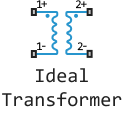Ideal Transformer
The perfect transformer.
blockType: AcausalFoundation.Electrical.Elements.IdealTransformer
|
Path in the library: |
Description
The Ideal Transformer unit represents an ideal transformer described by the following equations:
Where:
-
- primary voltage;
-
- secondary voltage;
-
- primary current;
-
- secondary winding current;
-
- transformation ratio.
This block can be used to represent either an AC transformer or a solid-state DC to DC converter. To model a transformer considering inductance and mutual inductance, use the Mutual Inductor block.
Each of the two electrical networks connected to the primary and secondary windings must have its own Electrical Reference block.
Ports
The block has four electrical ports. Polarity is indicated by + and - . Ports labelled 1+ and 1- are connected to the primary winding. Ports labelled 2+ and 2- are connected to the secondary winding.
Parameters
Winding ratio - transformation ratio
1 (by default) | scalar | positive.
The transformation ratio, or the ratio of the number of turns of the primary winding to the number of turns of the secondary winding.
Initial value of primary current i1 - initial value of primary current i1
`0 (By default)
Initial value of primary current .
Initial value of primary voltage v1 - initial value of primary voltage v1
`0 (By default)
Initial value of primary voltage .
Initial value of secondary current i2 - initial value of secondary current i2
0 (By default)
Initial value of secondary current .
Initial value of secondary voltage v2 - initial value of secondary voltage v2
0 (By default)
Initial value of secondary voltage .
